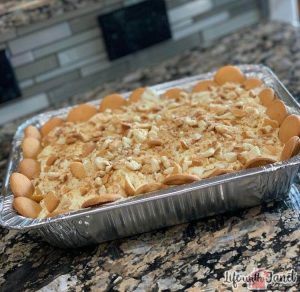
This recipe isn’t about fitting into any trendy diet — it’s not low-fat, low-sugar, paleo, vegan, or low-carb. What it is is the genuine article: a rich, comforting dessert that tastes just like the banana puddings our great-grandmothers lovingly made decades ago. If it was good enough for them, it’s definitely good enough for us.
In the South, banana pudding holds a near-sacred place at the table. It’s more than just a dessert—it’s a tradition. This beloved sweet treat is a staple at church suppers, potlucks, VFW dinners, and Fourth of July picnics. The absence of banana pudding at any of these gatherings is almost unthinkable. In fact, if you don’t bring banana pudding, you might just be the one who ruins the party.
But where did this Southern obsession with banana pudding begin? According to Our State Magazine, the popularity of banana pudding took root after the Civil War, particularly in port cities like New Orleans and other parts of Louisiana where bananas first made their way into America from Latin America. Serious Eats adds that home cooks started experimenting by incorporating bananas into traditional English trifles—a dessert made up of layers of cake, custard, fruit, and whipped cream. This innovation gave rise to a unique, distinctly American dessert that quickly gained momentum. By the early 20th century, banana pudding recipes were regularly appearing in cookbooks and newspaper columns, solidifying the dish’s place in culinary history.
The story continues to unfold in the 1960s when the completion of the interstate highway system made it easier and faster to ship exotic fruits like bananas all over the United States. Around this same time, Nabisco introduced their iconic Nilla Wafers, which paired perfectly with the creamy custard and fresh bananas. This magical combination was a game-changer. Just like that, a beloved national dessert was born and has remained a fan favorite ever since.
Regional variations exist, but the true Southern banana pudding is a work of art, carefully layered with vanilla wafers, thinly sliced bananas, and rich, velvety custard. Some people prefer to simply pour custard over a pile of wafers and bananas, but for me, the layered method is unbeatable. It allows the cookies to soak up the custard and banana flavors fully, resulting in a creamy, harmonious blend with every bite.
